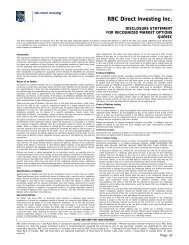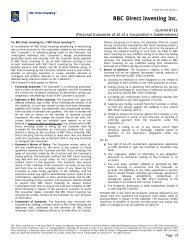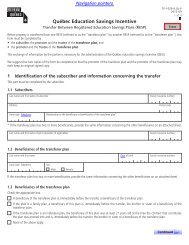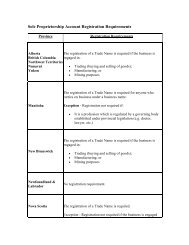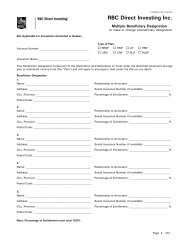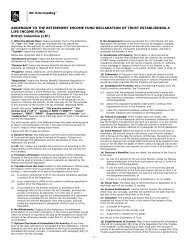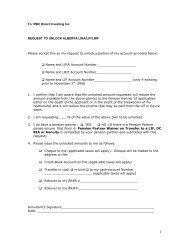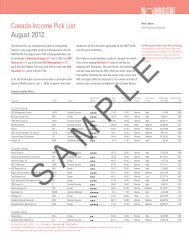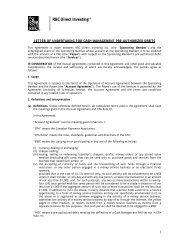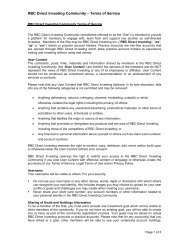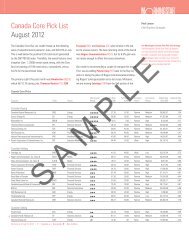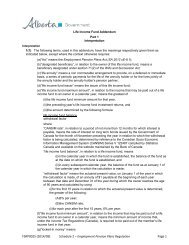View Sample PDF - RBC Direct Investing
View Sample PDF - RBC Direct Investing
View Sample PDF - RBC Direct Investing
Create successful ePaper yourself
Turn your PDF publications into a flip-book with our unique Google optimized e-Paper software.
Global Investment Outlook • Eric Lascelles • Daniel E. Chornous, CFA • John Richards<br />
It still doesn’t pay to expect the<br />
Canadian economy to grow at a<br />
materially different rate from the U.S.<br />
– history simply doesn’t bear this out –<br />
and so we look for 2.0% GDP growth in<br />
both 2012 and 2013. The 2013 forecast<br />
is a hair lower than our prior view<br />
and is motivated by the expectation<br />
that Canada’s housing market will<br />
continue to slow. The Canadian dollar is<br />
appropriately positioned at a few cents<br />
below the U.S.<br />
Indeed, when evaluating risks in<br />
Canada, there are both domestic and<br />
external threats. The external risks are<br />
widely appreciated – Europe’s crisis,<br />
China’s slowdown, the U.S. fiscal cliff.<br />
But domestic risks are also material.<br />
Probably the greatest domestic<br />
challenge is Canada’s housing market,<br />
which has defied gravity for years but<br />
is now losing altitude (Exhibit 29).<br />
Affordability remains reasonable in the<br />
context of current low interest rates,<br />
but a normalization of interest rates<br />
would render affordability statistics<br />
some 15% to 20% offside.<br />
Regulators have finally decided<br />
that enough is enough, and are<br />
endeavouring to deflate the housing<br />
market. Among these actions, the<br />
Bank of Canada is now talking of rate<br />
increases – an appropriate stance<br />
given so little remaining economic<br />
slack and the state of the housing<br />
market. But we suspect the central<br />
bank may struggle to actually pull the<br />
trigger before 2013 due to worsening<br />
global outcomes. Nonetheless, interest<br />
rates will eventually work their way<br />
higher, and with it Canada’s housing<br />
market will have to deflate. This may<br />
translate into a lean year for Canada’s<br />
economy as construction activity<br />
EXHIBIT 29.<br />
Average Home Price (Y/Y % Change)<br />
Competitiveness Gap (%)<br />
35<br />
25<br />
15<br />
5<br />
-5<br />
-15<br />
Home Prices Beginning to Fall in Parts of Canada<br />
National<br />
Vancouver<br />
Toronto<br />
-25<br />
2007 2008 2009 2010 2011 2012<br />
Source: CREA, <strong>RBC</strong> GAM<br />
EXHIBIT 30.<br />
Index Level<br />
30<br />
20<br />
10<br />
0<br />
-10<br />
-20<br />
-30<br />
-40<br />
800<br />
750<br />
700<br />
650<br />
600<br />
Canada–U.S. Economic Competitiveness<br />
Canada more<br />
competitive<br />
U.S. more<br />
competitive<br />
Canada now 30%<br />
less competitive<br />
than U.S.<br />
1981 1986 1991 1996 2001 2006 2011<br />
Note: Competitiveness Gap calculated as currency-adjusted unit-labour cost ratio<br />
between Canada and the U.S versus the average relationship from 1981 to 2011.<br />
Source: <strong>RBC</strong> GAM, Haver Analytics<br />
SAMPLE<br />
EXHIBIT 31.<br />
Commodities Have Tempered<br />
S&P Goldman Sachs Commodity Index (LHS)<br />
Barrel of WTI Oil (RHS)<br />
550<br />
60<br />
Jan-11 Apr-11 Jul-11 Oct-11 Jan-12 Apr-12 Jul-12<br />
Source: Haver Analytics, <strong>RBC</strong> GAM<br />
120<br />
110<br />
100<br />
90<br />
80<br />
70<br />
US$<br />
The global investment outlook <strong>RBC</strong> INVESTMENT Strategy coMMITTEE Summer 2012 I 23



